Slovakia's housing market shows signs of recovery
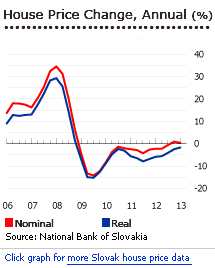
Slovakia’s house prices rose during the first quarter of 2013, after slowing price declines during 2012, at least in nominal terms. But when adjusted for inflation, residential prices fell by 1.7%, according to the National Bank of Slovakia (NBS).
House prices are down by almost 20% (-28.8% in real terms) from thre peak in Q2 2008 of €1,549 per sq. m. Compared to the previous quarter, Slovakia’s property prices were down by 0.6% (-1.1% in real terms) in Q1 2013. The housing boom in Slovakia lasted from 2006 to Q2 2008, with rises ranging from 14% to 35% per annum. The surge stopped in late 2008, and since then prices have fallen continuously.
The average price of houses rose by 3.9% to €1,133 per sq. m., during the year to Q1 2013. In contrast, house prices of flats declined by 0.5% to €1,298 per sq. m. On a quarterly basis, the roles were reversed as houses fell by 2.3%, while flats rose by 0.3%.
Of Slovakia’s regions, Zilina had the highest y-o-y price growth at almost 5% to €785 per sq. m. Trnava (1.9%), Presov (1%), and Bratislava (0.7%) also experienced annual house price hikes in Q1 2013. Bratislava region has the most expensive housing in the country, with an average price of €1,670 per sq. m. in Q1 2013.
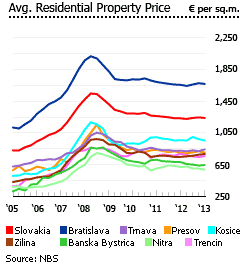
Trencin had the biggest price decline of around 5.4% y-o-y to Q1 2013, with an average house price of €645 per sq. m. It was followed by Nitra with a 5.2% y-o-y decline to €588 per sq. m. Banska Bystrica and Kosice also had price drops of 3.6% and 0.5%, respectively.
As of June 2013 the total volume of mortgage loans in Slovakia totaled €6.58 billion, an increase of 5.9% on June 2012, based on NBS figures.
Slovakia’s economy had meager growth of 0.9% y-o-y in Q2 2013, a slowdown from 2.6% y-o-y growth in Q2 2012. The economy is expected to slow expand by only 0.6% in 2013, due to the worsening external environment.
Apartment prices remain weak
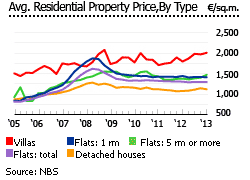
During Slovakia’s property boom, apartment prices rose 87% between 2005 and 2008 (70% in real terms), increasing from €635 per square meters to €1,080 per square meters.
- Smaller apartments (one room units) rose 104% (85% in real terms) 2005-2008, to €1,239 per square metre
- 5-room apartment prices rose 56% (39% in real terms)
- Detached house prices rose 40% (27% in real terms) during the boom years from 2005 to 2008, with average prices increasing from €680 per square meters to €862 square meters.
- Villa prices increased a meagre 25% (14% in real terms).
AVERAGE RESIDENTIAL PROPERTY PRICES |
||||
CHANGE |
||||
| SLOVAKIA | ||||
| REGIONS | ||||
| Bratislava | ||||
| Trvana | ||||
| Nitra | ||||
| Trencin | ||||
| Zilina | ||||
| Banska Bystrica | ||||
| Kosice | ||||
| Presov | ||||
| PROPERTY TYPE | ||||
| Total flats | ||||
| 1 - room | ||||
| 2 - rooms | ||||
| 3 - rooms | ||||
| 4 - rooms | ||||
| 5 - rooms | ||||
| Total houses | ||||
| Houses | ||||
| Villas | ||||
| Source: National Bank of Slovakia | ||||
Lower interest rates
Interest rates continue to be on a declining trend in 2012 up to the first half of 2013. As compared to the pre-crisis period, the average loan rates for June 2013 declined:
- Floating rate, or with IRF of up to 1 year – 3.8%,
- IRF over 1 and up to 5 years – 3.94%,
- IRF over 5 years – 4.56%.

The decline in Slovakia’s key rates was in accordance to the ECB’s another round of rate cuts that started in late 2011. After the ECB slightly tightened its key rate up to 1.5% from the then-lowest rate of 1% from April to October 2011, the bank reintroduced its rate cuts leading to an even lower rate of 0.5% in May 2013.
However as a reaction to the crisis, banks have become very cautious in their lending activities.
Small mortgage market

Loans for house purchases increased by 11.8% y-o-y to Q2 2013, partly due to lower interest rates, even though Slovakia’s GDP growth has slowed to 2% by the end of 2012. Slovakia has one of the lowest mortgage-debt-to-GDP ratios among EU countries, at around 19.2% of GDP in 2012.
Lower yields and rents
In contrast to the slowed house price drops from the previous year, Slovakia’s rental market experienced further decline in rents and yields in 2013.
Based on Global Property Guide research in July 2013, in Stare Mesto, Bratislava’s city centre:- Gross rental yields on larger units such as 120 sq. m. and 200 sq. m. apartments were lower at around 4.94% and 4.53%, respectively.
- Smaller units of 75 sq. m. have higher yields at 5.4%.
Outside Bratislava’s Old Town, rents and prices of flats are much cheaper. However, those less upscale districts of Ruzinov and Nove Mesto (Bratislava II & III), have higher gross rental yields than in Stare Mesto, ranging from 4.8% to 6.2%.
The average yield in Stare Mesto fell to almost 5% in July 2013, from 5.2% during the same period in the same years, while the average yield in Bratislava II and III dropped from 5.7% to 5.6%.
Meanwhile, the average rent in Stare Mesto declined by 3.4% y-o-y to €1,164 per month in July 2013. Bratislava II and III, on the other hand, experienced a sharp plunge of 37% from €1,044 per month to €657 per month during the same period.
This drop in rents in the recent years is attributed to increased housing supply around Bratislava. Even in 2009, when the global recession occurred, 3,741 dwellings were built. “Currently the primary residential market in Bratislava is a buyer’s market,” says REAS. However, fewer completions were expected in 2010 and 2011 due to limited access to construction loans and also because most developers focus on selling existing projects.
Rental market is limited
Slovakia’s rental market is smaller than that of most other EU countries. The country has the third highest rate of homeownership in the EU, with an owner occupancy rate of 90.2% in 2011, a sharp increase from 49.7% in 1990, lagrely due to the rent control system. Around 9.8% of Slovakia’s population are tenants. Only 0.1% of Slovakia’s housing stock is let out by private landlords, mainly in Bratislava.
The growth of owner-occupation is parly due to a contractual savings system (Bauspar) that makes it easy for Slovaks to obtain housing loans. This Bauspar system allows borrowers to take loans at lower interest rates, and the government pays an interest premium on the amount saved.
In 2005, the government decreed the abolition of rent control, effective July 1, 2007. However, the decree was never implemented. Rent deregulation has been postponed repeatedly, as Parliament refuses to deal with the highly sensitive issue.
Economic slowdown is expected in 2013
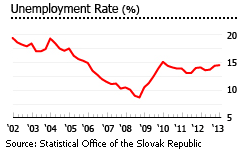
Slovakia had slow economic growth of about 2% in 2012, lower than the 3.2% growth recorded in 2011. The slowdown gathered pace felt in the first half of 2013, when Slovakia’s GDP rose by a meagre 0.9% during the year to Q2 2013.
Slovakia’s economic slowdown is expected to deepen this year. Both the OECD and the IMF have cut their growth forecasts.
IMF’s decision to cut the country’s growth outlook is due to weak domestic demand, and deteriorating developments in demand from trading partners, which is mainly in Europe, according to Slovak Finance Minister Peter Kažimír and James John, the head of the recent IMF mission to Slovakia.
Unemployment in Slovakia rose by 0.4 percentage points to 14.5% during the year to Q1 2013.
Slovakia is one of Eastern Europe’s most successful transition countries. Born in 1993 after seceding amicably from the Czech Republic (the two countries were formerly known as Czechoslovakia), it has a stable polity and liberal market economy.
Slovakia benefited from eight years’ reform under the centre-right coalition led by Mikulas Dzurinda (1998-2004) whose reforms won praise from international organizations, and who oversaw EU and Nato entry.
One of the most famous characteristics of the Slovak economy is its ‘flat tax’ of 19% on income, consumption, and corporate profits, operative since 2004. “It just works!” explained former minister of finance Ivan Miklos to a Cato Seminar.
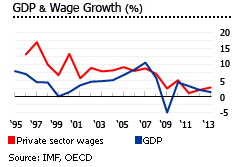
The economy’s rapid growth facilitated the country’s membership of the Organization for Economic Cooperation and Development (OECD) and the European Union (EU) in 2004. In December 2007 Slovakia became a full member of the Schengen Zone, allowing passport-free travel in the 24-member European nations.
Real GDP growth reached an impressive 10.5% in 2007, following 8.3% for 2006, 6.7% for 2005, and 5.1% for 2004. Kia, Volkswagen, and Peugeot Citroen all have large car plants in Slovakia.
In 2008 there was 5.8% growth, and then a collapse with the crisis to a 4.9% GDP contraction in 2009. The economy recovered quickly with GDP growth of 4.4% in 2010 and 3.2% in 2011.